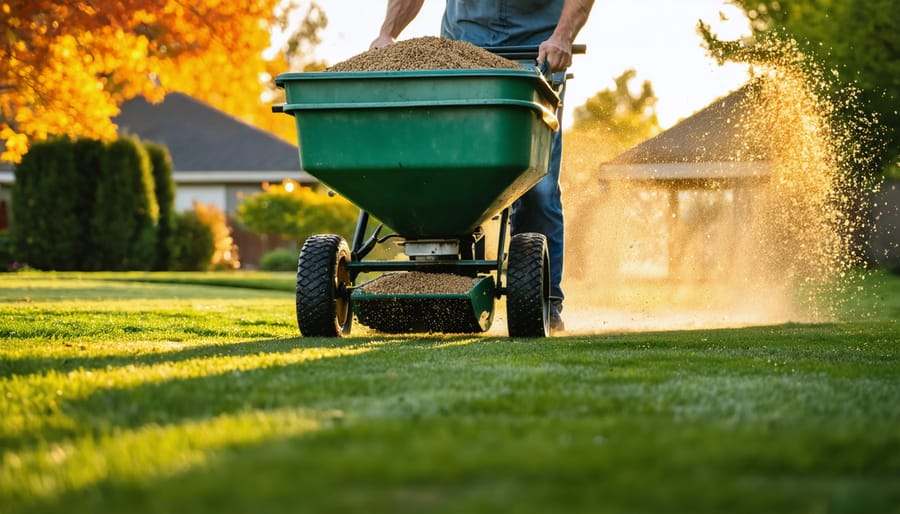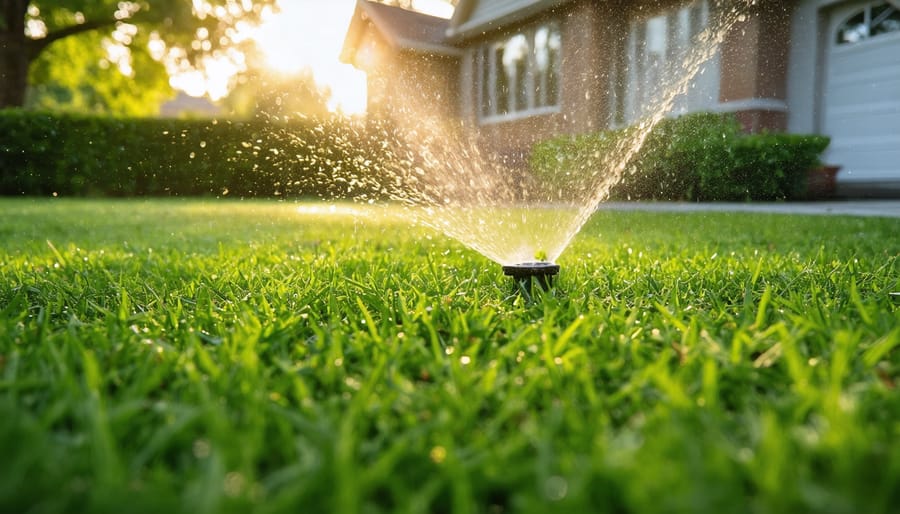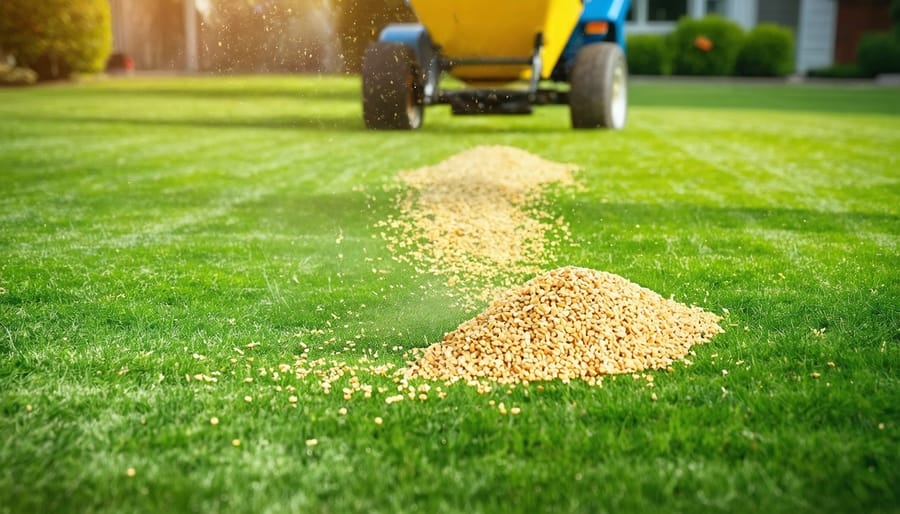September fertilization represents your lawn’s most critical feeding of the year—even more important than spring applications. While spring fertilization differs in its growth-stimulating purpose, fall feeding strengthens root systems when grass naturally channels nutrients downward, creating the foundation for next year’s lush, resilient turf.
The science is straightforward: cool-season grasses experience their second growth surge as temperatures drop, desperately seeking nutrients to fortify roots before winter dormancy. Miss this window, and you’re leaving your lawn vulnerable to winter stress, early spring weeds, and thin patches that plague homeowners come April.
Here’s what makes September fertilization uniquely powerful. Your grass isn’t focused on producing blade growth—it’s building an underground fortress. Those nutrients you apply now travel directly to root development and carbohydrate storage, which translates to earlier green-up, better drought tolerance, and thicker turf density next season. It’s essentially a six-month investment with compounding returns.
This guide cuts through the confusion about timing, product selection, and application methods. You’ll discover exactly which days in September matter most for your climate zone, understand the N-P-K ratios that deliver results without environmental waste, and learn the sustainable techniques that reduce chemical dependency while maximizing effectiveness. Whether you’re tackling your first fall fertilization or refining your established routine, these evidence-based strategies transform September feeding from routine maintenance into your lawn’s competitive advantage.
The Science Behind September: What Makes Fall Fertilization Different
How Cool-Season Grasses Behave in Fall
After the stress of summer lawn care, cool-season grasses like Kentucky bluegrass, perennial ryegrass, and tall fescue experience what I like to call their “second spring.” As temperatures cool down in September, these grasses shift into their most active growth phase of the entire year.
Here’s what’s happening beneath your feet: while summer heat forced your grass into survival mode—conserving energy and slowing growth—falling temperatures and increased moisture from autumn rains trigger a remarkable transformation. Root systems dive deeper into the soil, storing energy for winter survival. Above ground, your lawn produces lush new blades and fills in thin spots naturally.
This biological awakening is precisely why September fertilization is so effective. Think of it as fueling up before a long journey. Your grass is actively seeking nutrients to strengthen roots and build carbohydrate reserves, making it incredibly efficient at absorbing and utilizing whatever you feed it. Unlike spring fertilization, which primarily promotes top growth that requires frequent mowing, fall feeding directs nutrients toward root development and overall plant health.
The magic window typically runs from early to mid-September when soil temperatures hover between 50-65°F—warm enough for nutrient uptake but cool enough to encourage robust root growth rather than excessive leaf production. This natural rhythm makes September feeding one of the smartest investments you can make in your lawn’s long-term health and sustainability.
Root Development vs. Blade Growth
Here’s something that surprises many lawn care enthusiasts: when you fertilize in September, you’re feeding what you can’t see rather than what you can. Unlike spring fertilization, which promotes that vigorous green growth we all love to show off, fall feeding works its magic underground.
Think of September fertilization as an investment in your lawn’s foundation. As temperatures cool and grass blades slow their upward march, your turf shifts its energy downward, focusing on root development. The nutrients you apply now fuel this underground expansion, creating a dense, robust root system that will pay dividends come spring.
This root-focused growth is precisely why fall fertilization is so sustainable and effective. You’re not pushing your lawn to produce excessive top growth that requires constant mowing and watering—both resource-intensive activities. Instead, you’re building resilience from the ground up. Those deeper, stronger roots mean your lawn will be better equipped to access water and nutrients during next summer’s heat, reducing your need for frequent watering and additional fertilizer applications.
The practical benefit? A lawn that naturally outcompetes weeds, recovers quickly from stress, and stays greener longer without excessive inputs. That’s smart, sustainable lawn care at its finest.
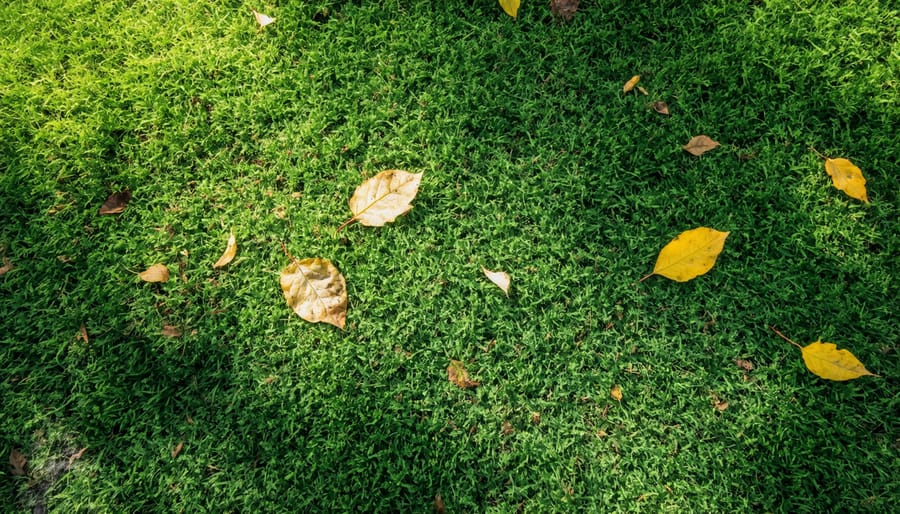
What Your Lawn Actually Needs in September
The Ideal NPK Ratio for Fall Feeding
When September rolls around, your lawn’s nutritional needs shift dramatically from the summer months, and understanding the NPK ratio becomes your secret weapon for fall success. Think of it this way: while summer feeding is like giving your grass a quick energy boost, September fertilization is more like preparing an athlete for a marathon.
For September, you’ll want a fertilizer with a higher nitrogen content compared to phosphorus and potassium—typically something in the range of 20-8-8 or 24-4-12. That first number, nitrogen, is the star of the show right now. It promotes the lush, green growth and helps your grass store energy in its roots before winter dormancy sets in. I’ve seen lawns transform from tired and pale to vibrant and resilient within just a few weeks of proper fall feeding.
Phosphorus, that middle number, supports root development, which is exactly what you want as your grass prepares for winter. However, you don’t need as much of it now since root establishment happens most aggressively in spring. Some regions have even restricted phosphorus use for environmental reasons, so check your local regulations—sustainability matters!
Potassium, the final number, is your lawn’s winter coat. It strengthens cell walls, improves disease resistance, and helps grass withstand cold stress. Think of it as fortifying your lawn’s immune system before the harsh months ahead.
A balanced approach might look like a 3-1-2 or 4-1-2 ratio, meaning if your nitrogen is at 24 percent, you’d want phosphorus around 6-8 percent and potassium around 12 percent. This combination gives your lawn everything it needs to green up quickly while building those crucial winter defenses. Remember, slow-release nitrogen formulas work best for sustainable feeding—they prevent nutrient runoff and provide steady nourishment throughout fall.
Slow-Release vs. Quick-Release: Which Works Better in Fall
When choosing your September fertilizer, you’ll encounter two main options: quick-release and slow-release formulas. While quick-release fertilizers deliver nutrients rapidly (think of them as an espresso shot for your lawn), they’re not ideal for fall applications. They can encourage excessive top growth right when your grass should be focusing energy on root development, and they wash away more easily with September rains, potentially polluting waterways.
Slow-release fertilizers, on the other hand, are the clear winner for September feeding. These formulas break down gradually over 6-12 weeks, providing steady nutrition as temperatures cool. This extended feeding period perfectly aligns with your lawn’s natural fall growth cycle, supporting root development without the wild growth spurts that make mowing a chore.
From a sustainability perspective, slow-release options shine even brighter. They significantly reduce nutrient runoff—a major environmental concern with lawn care. You’re less likely to overfeed, which means fewer resources wasted and a healthier ecosystem in your yard. Many slow-release products also use coated granules that respond to soil temperature and moisture, releasing nutrients only when conditions are right for grass absorption.
The investment pays off too. Though slow-release fertilizers cost slightly more upfront, you’ll apply less product overall and see better results. Look for products with at least 50% slow-release nitrogen on the label. Your lawn will reward you with deeper roots, better drought resistance next summer, and that enviable green-up come spring—all while treading more lightly on the environment.
Timing It Right: Early, Mid, or Late September?
Regional Considerations and Climate Zones
September’s ideal timing for lawn fertilization isn’t one-size-fits-all—your location makes all the difference! Understanding your USDA hardiness zone helps you hit that sweet spot when your grass is actively growing but temperatures are cooling down.
If you’re in northern zones (3-6), early September is your window of opportunity. Cool-season grasses like Kentucky bluegrass and fescue are waking up from summer dormancy and ready to absorb nutrients before winter arrives. Aim for that first or second week of September when daytime temperatures hover around 60-75°F.
For transitional zones (7-8), mid-September typically works best. You’ll want to wait until the worst of the summer heat passes but fertilize early enough for roots to establish before cold weather hits. Watch your local weather patterns—a string of cooler days signals it’s time to act.
Southern gardeners in zones 9-11 face a different scenario entirely. If you’re maintaining warm-season grasses like Bermuda or St. Augustine, September fertilization might not be necessary at all. These grasses are winding down for their dormant period, and late-season feeding can actually stress them. Instead, focus your fertilization efforts in late spring and early summer when warm-season varieties are actively growing.
The key is observing your lawn’s behavior alongside your local climate. A sustainable approach means working with your grass’s natural rhythm rather than against it. When you fertilize at the right time for your region, you’ll use less product while achieving better results—a win for both your lawn and the environment.
Step-by-Step: How to Fertilize Your Lawn in September
Pre-Application Preparation
Before you spread that September fertilizer, let’s talk about setting your lawn up for success. Think of this as creating the perfect canvas before painting—a little prep work now makes all the difference.
**Start with a soil test.** I know, I know—it’s not the most exciting task on your weekend agenda, but here’s why it matters: applying fertilizer without knowing what your soil actually needs is like throwing ingredients into a recipe blindly. Your local extension office or a home test kit (around $15-20) will reveal your soil’s pH and nutrient levels. Most cool-season grasses thrive between 6.0-7.0 pH, and you’ll want to know if you’re deficient in nitrogen, phosphorus, or potassium before you buy anything.
**Adjust your mowing height** a few days before fertilizing. Set your mower to around 3-3.5 inches—this height is ideal because it allows the fertilizer to reach the soil while maintaining enough blade surface for photosynthesis. Remove no more than one-third of the grass height, and leave those clippings on the lawn if possible. They’ll decompose and return nutrients to the soil naturally—a sustainable win!
**Check your watering schedule.** Your lawn should be slightly moist (not soaking wet) before application. If it’s been dry, water deeply 1-2 days before fertilizing. This helps activate the soil microorganisms that’ll work with your fertilizer and prevents product from simply sitting on dry, compacted ground where it can’t do its job effectively.
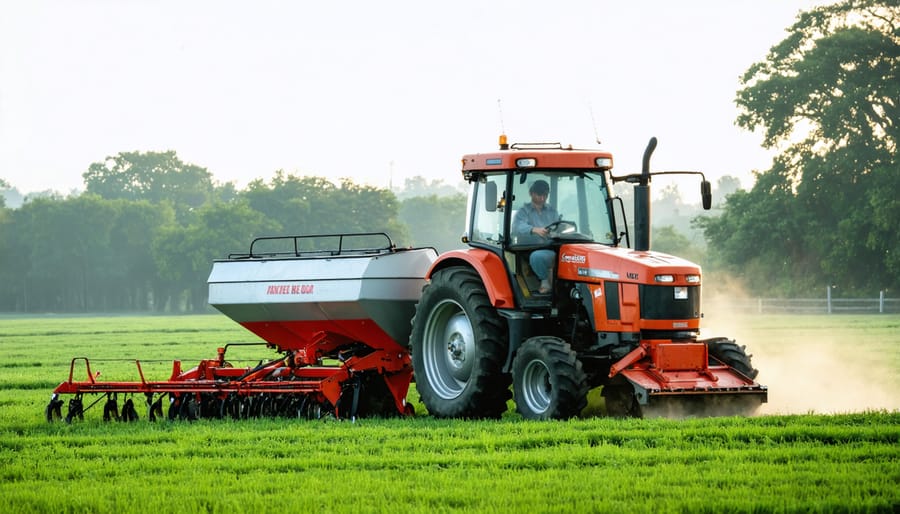
Application Techniques That Actually Work
Getting fertilizer onto your lawn might seem straightforward, but the application method makes all the difference between a lush, even carpet of green and those embarrassing stripes your neighbors will definitely notice.
**Choosing Your Spreader**
For most home lawns, a broadcast (rotary) spreader works beautifully, distributing granules in a wide arc that covers ground quickly. Drop spreaders offer more precision along edges and flower beds, but they’re slower and require perfect wheel alignment to avoid those telltale stripes. Whichever you choose, proper spreader equipment setup ensures accurate application rates—calibrate before you start.
**The Overlap Method**
Here’s where most people go wrong: they either overlap too much (wasting fertilizer and risking burn spots) or leave gaps (creating lighter green stripes). Aim for a slight overlap of about one wheel width with broadcast spreaders. I like to use the edge of my previously fertilized strip as a guide, keeping my wheel just inside that line.
**Avoiding Common Mistakes**
Never fill your spreader on the lawn—spills create concentrated burn spots that take months to recover. Walk at a steady, consistent pace; speeding up or slowing down changes application rates. For the most even coverage, apply half your fertilizer walking in one direction, then the remaining half perpendicular to your first pass.
Always water within 24 hours to activate the nutrients and prevent burning, especially during warmer September days.
Post-Application Care
After applying your September fertilizer, water your lawn lightly with about a quarter-inch of water to help activate the nutrients and wash them down to the root zone. Avoid heavy watering, which can wash away the fertilizer before it’s absorbed. If rain is in the forecast within 24-48 hours, you can skip this step and let nature do the work—a sustainable approach that conserves water!
Wait at least 2-3 days before mowing to allow the fertilizer to settle and begin working its magic. When you do mow, keep your blade height at 2.5-3 inches to maintain healthy grass that’s better equipped to absorb nutrients.
Within 7-10 days, you’ll notice your lawn taking on a richer, deeper green color as the nitrogen kicks in. Over the following weeks, your grass will develop stronger roots and thicker growth—exactly what you want heading into fall. This slow, steady transformation means your lawn is building resilience for winter while staying environmentally balanced. Keep an eye out for any yellowing or uneven growth, which might indicate application issues worth addressing before your next feeding.
Common September Fertilization Mistakes (And How to Avoid Them)
The Over-Fertilization Trap
I get it—when you see your neighbor’s lush green lawn, it’s tempting to think they’re using double the fertilizer. But here’s the truth: more fertilizer doesn’t mean a better lawn. In fact, over-fertilization is one of the biggest mistakes I see gardeners make in September.
When you apply too much nitrogen, your grass grows so quickly that it weakens its root system right when it should be strengthening for winter. You’ll end up mowing constantly and dealing with disease-prone turf. Even worse, excess fertilizer doesn’t just stay in your yard—it washes into waterways, contributing to algae blooms and harming aquatic ecosystems. This is why sustainable lawn care matters so much.
So how much is enough? Here’s a simple calculation: most cool-season lawns need about 0.75 to 1 pound of nitrogen per 1,000 square feet in September. Check your fertilizer bag’s NPK ratio (those three numbers on the front). If you’re using a 20-5-10 fertilizer, that means 20% nitrogen. To deliver 1 pound of nitrogen per 1,000 square feet, you’d need 5 pounds of that fertilizer (1 ÷ 0.20 = 5). Measure your lawn area, do the math, and apply only what’s needed—your wallet and the environment will thank you.
Fertilizing Without Testing Your Soil First
Applying fertilizer without testing your soil first is like cooking without tasting—you’re guessing at what’s needed. A simple soil test (available at your local extension office or through home kits) reveals your soil’s pH and existing nutrient levels, showing you exactly what your lawn lacks and what it already has in abundance.
Here’s why this matters: if your soil already has high phosphorus levels, adding more through fertilizer wastes your money and contributes to water pollution through runoff. Excess nutrients don’t just disappear—they leach into groundwater or wash into storm drains, eventually harming local waterways and aquatic life.
Testing takes the guesswork out of September fertilizing. You’ll discover whether your lawn needs a balanced fertilizer or something more targeted, potentially saving 30-40% on products you don’t actually need. Plus, you’ll avoid the common problem of over-fertilizing, which can burn your grass and create more thatch buildup. Think of soil testing as your personalized lawn care roadmap—it’s a small upfront investment that pays dividends in healthier grass and environmental stewardship.
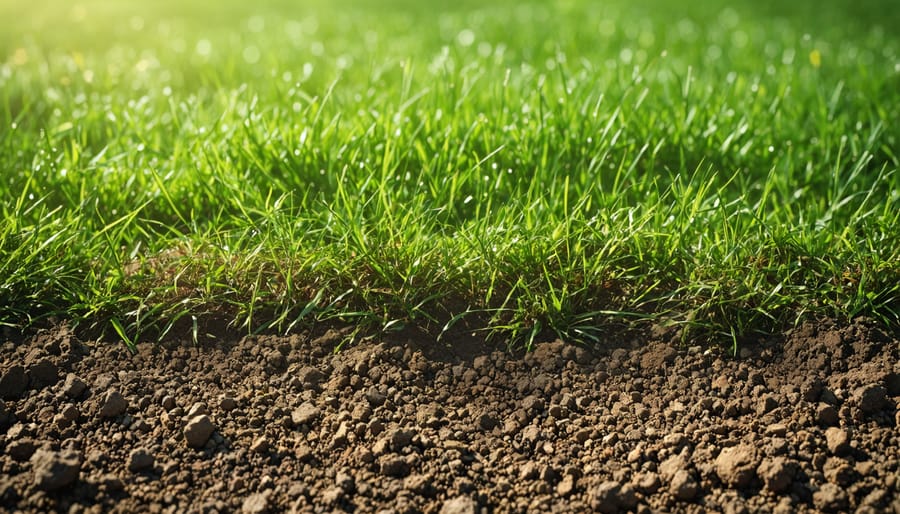
Pairing September Fertilization with Other Fall Lawn Care Tasks
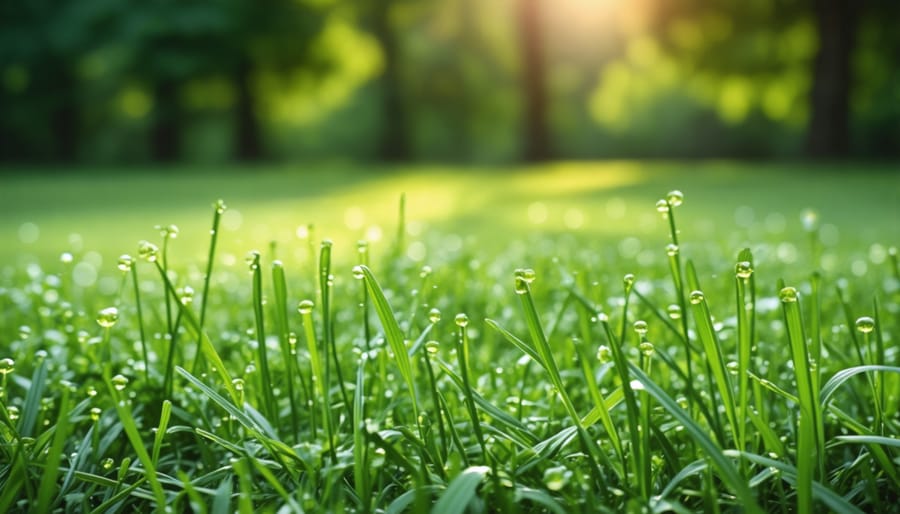
Should You Aerate Before or After Fertilizing?
Here’s the golden rule: always aerate first, then fertilize. Think of it this way—aeration creates thousands of tiny pathways into your soil, like opening doors for nutrients to walk right in. If you fertilize before aerating, you’re essentially wasting that precious fertilizer on compacted soil where it can’t reach the root zone effectively.
The timing is simple but important. Aerate your lawn, then apply fertilizer within 48 hours while those cores are still fresh and the channels are wide open. This one-two punch allows your September fertilizer to penetrate deeply, reaching the root system where it’s needed most. The aeration holes act like funnels, directing nutrients, water, and oxygen straight down to hungry grass roots.
I’ve seen homeowners make the mistake of waiting a week between aeration and fertilization, thinking they’re giving the lawn time to “recover.” Don’t fall into this trap! The whole point is capitalizing on those open channels before they naturally close up. This sequencing is especially critical in September when your grass is actively storing nutrients for winter survival. By aerating first, you’re maximizing every dollar spent on fertilizer while supporting sustainable lawn care—you’ll need less product because more actually reaches its destination.
Sustainable September Fertilization: Organic and Eco-Friendly Options
Organic Fertilizer Options That Actually Work
Let’s be honest—organic fertilizers work differently than their synthetic counterparts, and that’s perfectly okay. I’ve learned through years of trial (and a few lawn-related errors) that setting realistic expectations is key to success.
**Compost and Compost Tea** remain my top recommendation for September feeding. A quarter-inch layer of quality compost provides slow-release nutrients your lawn can use all fall. It won’t deliver that dramatic green-up you might see with synthetic options, but it builds soil health that pays dividends for years. Compost tea works wonderfully as a supplemental boost, especially if you’re dealing with compacted soil.
**Milorganite** deserves its reputation as a reliable organic option. This heat-dried biosolid fertilizer releases nutrients gradually, making over-application nearly impossible—perfect for beginners. Its 6-4-0 NPK ratio suits fall feeding well, though you’ll need patience as results appear over weeks, not days.
**Alfalfa meal and soybean meal** offer excellent nitrogen sources with typical NPK ratios around 3-1-2. I mix these with kelp meal (0-0-1) for added micronutrients and root stimulation—especially valuable before winter.
**Blood meal** provides faster nitrogen release (12-0-0) if you’re treating specific problem areas, though I prefer slower options for overall lawn health in September.
The reality? Organic fertilizers typically cost more per application and require higher application rates than synthetic products. However, they’re feeding your soil ecosystem, not just your grass. That investment compounds over time, creating healthier, more resilient turf that requires less intervention each season.
September fertilization isn’t just another task on your lawn care calendar—it’s truly one of the smartest investments you can make for your grass. As we’ve explored throughout this guide, this narrow window of opportunity sets the stage for everything that follows: robust root development, improved winter resilience, and that enviable spring green-up that’ll have your neighbors wondering what your secret is.
The beauty of September fertilizing is that it works *with* nature rather than against it. While your grass is naturally programmed to focus on root growth during this cooler period, you’re simply providing the fuel it needs to maximize that biological process. Think of it as winter preparation that pays dividends for months to come.
So don’t let this season slip away! Whether you choose a slow-release organic option or a balanced synthetic fertilizer, taking action now means less work next spring and a healthier, more sustainable lawn year-round. You’ve got the knowledge, you understand the timing, and you know what products work best for your situation.
Grab that spreader, double-check your weather forecast for some upcoming rain, and get out there. Your lawn is ready, willing, and quite literally waiting to absorb those nutrients. Future you—the one admiring that thick, lush spring lawn—will be incredibly grateful you didn’t procrastinate on this one.
